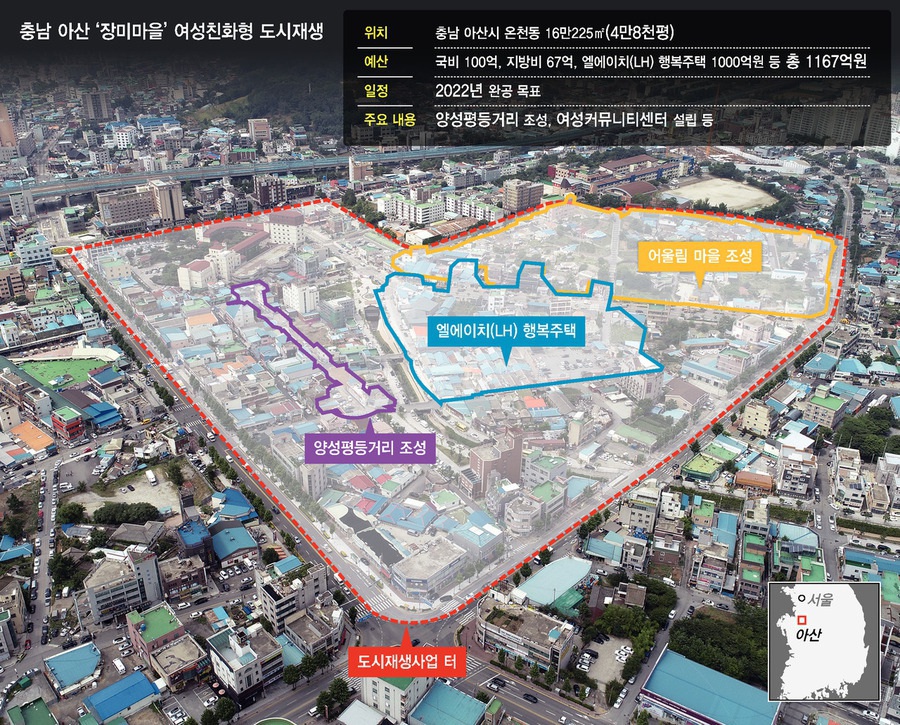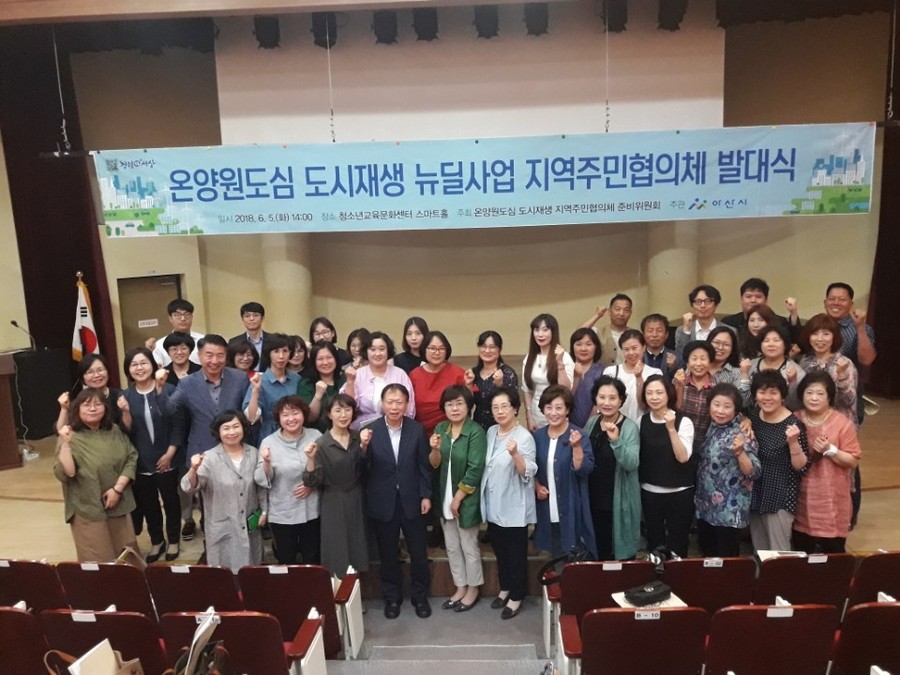 |
|
The urban regeneration plan for Asan, South Chungcheong Province
|
Asan City converts red light district into “Rose Village”
A visit to the “Rose Village” tourism spot in the Onyang (Oncheon) Hot Spring neighborhood of Asan, South Chungcheong Province, on the afternoon of Sept. 17 showed little evidence of what used to be known as the province’s biggest red light district. The dreary side streets packed with bars had disappeared, with spacious streets in place allowing people to travel comfortably around. The change came after Asan City Hall bought out the adult entertainment businesses and tore down their buildings to make a new road. Of the 80 or so establishments that existed in the 1970s and 1980s, just five to six remain. With the neighborhood’s atmosphere so drastically changed, even those remaining businesses are currently in discussions with the city over similar purchasing.
An even bigger transformation is now being planned for Rose Village, once a symbol for the violation of women’s rights. The Ministry of Land, Infrastructure, and Transport (MOLIT) granted approval in July for a “woman-friendly” urban regeneration project by the city of Asan. Asan is the first South Korean city to emphasize women in the revitalization of a decaying neighborhood.
“Rose Village has been a place of suffering and human rights infringements against women,” said Jang Chi-won, director of the city’s urban regeneration bureau.
“Rather than adopting an urban regeneration approach of completely wiping it out, we chose to make Rose Village into a woman-friendly place out of a sense of social responsibility for past mistakes,” Jang explained. The idea is to remember a past where women’s rights were disregarded and send a clear message that sex work was not simply a personal choice, but something that society bears responsibility for. Covering an area of 160,225 square meters in the hot spring neighborhood, the woman-friendly urban regeneration project in the Onyang inner city is receiving a total budget of 116.7 billion won (US$97.8 million), including 10 billion won (US$8.38 million) from the state, 6.7 billion won (US$5.6 million) in local funding, and 100 billion won (US$83.8 million) through LH’s “Happy Housing” project. The effort is now fully under way, with a target completion date in 2022.
What sort of “woman-friendly urban regeneration” does Asan envision? A key part is the creation of a “gender equality road” within the village site. The aim is to provide a space that women can feel comfortable visiting at any time, with a women’s community center to be built on the road to assist women in starting businesses and finding employment. Also under consideration is a space for remembering and reflecting on the neighborhood’s past as a center for sex work. Other plans include the establishment of specialized stores to support economic activity by women, young people, and cooperatives, among others. At another site not far from Rose Village, a shelter for single parents, victims of domestic violence, and other vulnerable members of society is being planned, along with a space for community activities such as care-giving for senior citizens and side employment.
 |
|
Urban regeneration project planners gather at Asan City Hall. (provided by Asan City Hall)
|
Resident council with five subcommittees established for discussions
The biggest concern is communication with residents. For its urban regeneration effort, the city of Asan has pursued ongoing discussions through the creation of a resident council with five subcommittees focusing on women, merchants, social economy, young people, and culture/arts. The subcommittees meet periodically to consider matters ranging from the details of the urban regeneration to measures to prevent gentrification. An “urban regeneration university” program has also been instituted to provide education and increase resident involvement.
“After being a stay-at-home mother for over 10 years, I really wanted to work, and now I give lectures,” explained Lee Hyeon-jeong, director of the council’s subcommittee for women.
“At first, I wasn’t really sure what to do, and it was a big struggle,” she recalled.
Lee said she hoped the gender equality street and women’s community center “will be a place for opportunities, where women and other vulnerable members of society can meet comfortably and share their concerns.” Admitting that she feels as much trepidation as anticipation, she explained, “The idea of ‘woman-friendly’ is very abstract, and there have been some difficulties with this being the first example of it being applied to urban regeneration.”
“I’d like it if we had specialized female staff members [considering] how the residents’ opinions can be translated into actual projects,” she added.
Urban regeneration projects like Asan’s, with their focus on increasing city sustainability, are undergoing continued evolution. Urban regeneration refers to the economic, social, physical, and environmental revitalization of a city that is decaying due to loss of population, changes in industry structure, and dilapidation of the residential environment. It is of a different nature from redevelopment or reconstruction projects, which involve large-scale civil engineering efforts to tear down neighborhoods and build new ones. Different experiments with urban regeneration have become a global trend. Every 20 years, the UN has held summits to address urban and human settlement issues; for the past 40 years, the agenda has been focused chiefly on the areas of residential rights and basic services.
But the paradigm began shifting in 2015. Seventeen Sustainable Development Goals (SDGs) – which include alleviating inequality and achieving sustainable cities – were adopted at a UN General Assembly meeting with the approval of 193 member countries. The issue is being examined along different lines among predictions that have 70% of the world’s population residing in cities by 2030. As an urban agenda for the next 20 years, the UN adopted a “New Urban Agenda” encompassing areas such as social integration, the environment, local economies, people-centered spatial planning, and urban governance. The aim of the New Urban Agenda is to achieve cities that are socially integrated and inclusive, provide jobs, and are ecologically sound and resilient.
Urban decay leads to village loss, urgent need for urban regeneration
The South Korean government has also taken proactive steps, enacting the Special Act on Promotion of and Support for Urban Regeneration in 2013. In March 2018, the Moon Jae-in administration announced an “Urban Regeneration New Deal roadmap” based on entrepreneurship by young people and innovative growth as a way of revitalizing decaying cities. According to figures from the Korea Research Institute for Human Settlements, a total of 84 cities, counties, and districts (37% of the total) and 1,383 townships and neighborhoods (40%) – mostly in smaller provincial cities – are threatened with disappearance over the next 30 years due to population loss and aging trends. As even large cities face increasing issues with decaying structures, urban regeneration has become a necessity rather than an option.
Gunsan, North Jeolla Province, is considered the leading success story among past urban regeneration projects. The local economy there has been making a comeback with rising tourist visits following the creation of “cultural base infrastructure” based on historical and cultural assets from the Japanese occupation and modern era. As recently as 2014, there were over 100 commercial vacancies in the downtown area centering on the neighborhoods of Wolmyeong, Haesin, and Jungang; now they are reported to be in short supply. Suncheon, South Jeolla Province, has also won praise, earning the highest urban regeneration rating two years running. Ongoing urban regeneration efforts with the construction of village broadcasters and libraries have led to the number of housing vacancies falling from 187 in 2014 to seven as of last year, with a resident satisfaction rate exceeding 90%. “Resident involvement” has been the chief emphasis in places where urban regeneration has been a success – suggesting that the key to success lies in having residents themselves participating in creating satisfactory cities.
Limits placed by time constraints
Some limits have also become apparent. Because of the government funding involved, the efforts can end up appearing more or less the same as local governments compete to pursue urban regeneration efforts. Hanok (traditional Korean home) villages and murals have gone up all over South Korea, while the building of memorials has become a routine part of the urban regeneration menu. An official with one small local government currently pursuing urban regeneration explained, “The projects last three to five years, which is a tighter time frame than you think.”
“Residents need to be educated to understand what urban regeneration entails, and a lot of time for discussion is needed with all the different interests at play in terms of the project direction, including things like land and building purchasing,” the official said.
“With so little time available, you inevitably end up looking at what other regions have been doing. There needs to be more flexibility in the project periods.”
Others have suggested that women’s thoughts need to be more actively incorporated into the process. Choi Yu-jin, director of the gender equality policy promotion strategy office at the Korean Women's Development Institute, said, “Urban regeneration projects are about making sustainable cities, and a key part of that is reflecting the demands and stories of the people who live there.”
“In addition to ensuring adequate consideration of gender equality and the socially vulnerable, we also need women participating in the projects with a sense of agency,” she suggested.
Along the same lines, Choi added, “I do think it shows significant evolution for the city of Asan to make ‘woman-friendliness’ a central part of its urban regeneration.”
By Kim So-youn, senior research fellow at the Hankyoreh Economy & Society Research Institute
Please direct comments or questions to [english@hani.co.kr]










